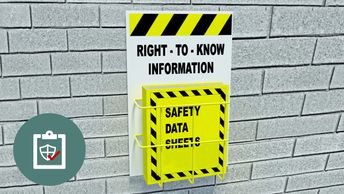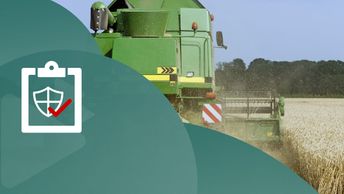Courses for Workplace Health and Safety - United States Compliance Training
- 220 Courses | 104h 27m 36s
COURSES INCLUDED
Compliance Course
Access to Employee Medical and Exposure RecordsCompliance Course
Active Shooter Short: Planning and Response – Brink's InsightsCompliance Course
Aerial Work PlatformsCompliance Course
Ammonia SafetyCompliance Course
AsbestosCompliance Course
Back Safety and Injury Prevention 2.0Compliance Course
Behavior-based Safety for SupervisorsCompliance Course
Behavior-based Safety Short: Role of Supervisors and EmployeesCompliance Course
Benzene AwarenessCompliance Course
BerylliumCompliance Course
Bloodborne Pathogen Awareness 2.0Compliance Course
CadmiumCompliance Course
Carcinogen SafetyCompliance Course
Chlorine SafetyCompliance Course
Cold StressCompliance Course
Combustible DustCompliance Course
Compliance Brief: 3D Printer SafetyCompliance Course
Compliance Brief: De-escalation TechniquesCompliance Course
Compliance Brief: Home Office Emergency and Disaster PreparednessCompliance Course
Compliance Brief: Illegal Drug Contamination AwarenessCompliance Course
Compliance Brief: Mpox (formerly called Monkeypox)Compliance Course
Compliance Brief: Preventing the Spread of COVID-19 at WorkCompliance Course
Compliance Brief: Safety and Health CommitteesCompliance Course
Compliance Brief: Summer Safety - Food and FunCompliance Course
Compliance Brief: Summer Safety in the WaterCompliance Course
Compliance Brief: Summer Safety on the WaterCompliance Course
Compliance Brief: Summer Vehicle SafetyCompliance Course
Compliance Brief: Utility Knife SafetyCompliance Course
Compliance Brief: WildfiresCompliance Course
Compliance Training Program ManagementCompliance Course
Compressed Air SafetyCompliance Course
Compressed Gas SafetyCompliance Course
Computer ErgonomicsCompliance Course
Confined Spaces 2.0Compliance Course
Confined Spaces in Construction 2.0Compliance Course
Construction Safety OrientationCompliance Course
Construction: Caught-in or Caught-betweenCompliance Course
Construction: Cranes OrientationCompliance Course
Construction: DemolitionCompliance Course
Construction: ElectrocutionCompliance Course
Construction: Hazard Communication: An Employee's Right to Understand 2.0Compliance Course
Construction: Heavy Equipment AwarenessCompliance Course
Construction: Lead AwarenessCompliance Course
Construction: Struck ByCompliance Course
Contractor SafetyCompliance Course
CPR Short: Performing CPR (Compression-only) – Scott’s StoryCompliance Course
Crane Signaling and CommunicationsCompliance Course
Cryogenic SafetyCompliance Course
Culture of Safety Short: Building a Safety Culture – Keith’s InsightsCompliance Course
Disaster Site WorkersCompliance Course
Driving Safety Short: Keys to Safe Driving – Gary's InsightsCompliance Course
Dry Ice Handling and ShippingCompliance Course
Electric Pallet Jack SafetyCompliance Course
Electric Vehicle Battery Short: EV Battery Explosion – Steve's StoryCompliance Course
Electrical Hazards: Shock, Electrocution, Arc Flash and Arc Blast (2021 Edition)Compliance Course
Electrical Hazards: Shock, Electrocution, Arc Flash and Arc Blast (2024)Compliance Course
Electrical Safety 2.0Compliance Course
Electrical Safety: Qualified Worker – Part 1Compliance Course
Electrical Safety: Qualified Worker – Part 2Compliance Course
Electrostatic Discharge SafetyCompliance Course
Emergency and Disaster PreparednessCompliance Course
Emergency Response in the WorkplaceCompliance Course
Ergonomics for Housekeeping Work 2.0Compliance Course
Ergonomics in the Workplace 2.0Compliance Course
Eye and Face Protection Short: Types and Uses – Chris's InsightsCompliance Course
Eyewashes and Emergency ShowersCompliance Course
Fall PreventionCompliance Course
Fall Protection Short: Personal Fall Arrest Systems – Chris’s InsightsCompliance Course
Fatigue ManagementCompliance Course
Fire Safety and Prevention 2.0Compliance Course
Fire Safety Short: Using a Fire ExtinguisherCompliance Course
First Aid: Automated External DefibrillatorCompliance Course
First Aid: BasicCompliance Course
First Aid: CPRCompliance Course
First Aid: CPR (Compression-only)Compliance Course
First Aid: Medical EmergenciesCompliance Course
First Aid: Mental Health AwarenessCompliance Course
Flammable LiquidsCompliance Course
Food Allergen SafetyCompliance Course
Food Safety and HandlingCompliance Course
Foodservice Worker Safety 2.0Compliance Course
Forklift Operation 1: Safety Inspection and MaintenanceCompliance Course
Forklift Operation 2: Stability and CapacityCompliance Course
Forklift Operation 3: Load HandlingCompliance Course
Forklift Operation 4: Traveling and ManeuveringCompliance Course
Forklift Safety Awareness 2.0Compliance Course
Forklift Safety Short: Pedestrian Safety from Forklift TrafficCompliance Course
Forklift Safety Short: Traveling with a ForkliftCompliance Course
Formaldehyde SafetyCompliance Course
General Safety for Facility Supervisors or ManagersCompliance Course
Globally Harmonized System of Classification and Labeling of Chemicals (GHS)Compliance Course
Hand and Power Tool SafetyCompliance Course
Handling Hazardous DrugsCompliance Course
Hazard Communication in the Office: An Employee's Right to Understand 2.0Compliance Course
Hazard Communication Short: Safety Data Sheet BasicsCompliance Course
Hazard Communication: An Employee's Right to Understand 2.0Compliance Course
Hazardous Material Handling and StorageCompliance Course
Hazardous Materials and Spills in the WorkplaceCompliance Course
Hazards to Outdoor WorkersCompliance Course
Hearing Conservation 2.0Compliance Course
Heat Illness Prevention for Supervisors – OSHA National Emphasis ProgramCompliance Course
Heat Stress Recognition and PreventionCompliance Course
Heat Stress Short: Preventing, Recognizing, and Treating Heat IllnessCompliance Course
Hexavalent ChromiumCompliance Course
Home Office: Ergonomics 2.0Compliance Course
Home Office: Fire and Emergencies 2.0Compliance Course
Home Office: Greener SpacesCompliance Course
Home Office: SecurityCompliance Course
Home Office: Slips, Trips, and Falls 2.0Compliance Course
Hot Work PermitsCompliance Course
Housekeeping on the JobCompliance Course
Hydraulic Fluid SafetyCompliance Course
Hydrogen SulfideCompliance Course
Incident Investigation and ReportingCompliance Course
Incident Investigation Short: Investigation Procedures and Fact FindingCompliance Course
Indoor Hoisting and RiggingCompliance Course
Industrial ErgonomicsCompliance Course
Industrial Robot Safety AwarenessCompliance Course
Infectious DiseasesCompliance Course
Injury and Illness Prevention ProgramCompliance Course
Introduction to Industrial HygieneCompliance Course
Introduction to OSHACompliance Course
Introduction to ToxicologyCompliance Course
IsocyanatesCompliance Course
Job Hazard AnalysisCompliance Course
Laboratory SafetyCompliance Course
Ladder Safety 2.0Compliance Course
Ladder Safety Short: Fall from a Ladder – Brandon’s StoryCompliance Course
Ladder Safety Short: Proper Use – Chris's InsightsCompliance Course
Laser SafetyCompliance Course
Lead Awareness in General IndustryCompliance Course
Liquefied Petroleum Gas (LPG)Compliance Course
Lithium-ion Battery Safety for Tools and DevicesCompliance Course
Lithium-ion Battery Short: Response to a Fire – Steve’s StoryCompliance Course
Lockout/Tagout 2.0Compliance Course
Lockout/Tagout for Authorized Persons 2.0Compliance Course
Lockout/Tagout Short: Control Hazardous Energy – Mike's InsightsCompliance Course
Machine Guarding 2.0Compliance Course
Machine Guarding Short: Safeguarding Your Employees – Mike's InsightsCompliance Course
Machinery Hazards Short: Amputation – Scott’s StoryCompliance Course
Marijuana and Workplace SafetyCompliance Course
Mental Health Short: First Aid for Mental Health IssuesCompliance Course
Mobile Crane Operator SafetyCompliance Course
Mobile Elevating Work Platforms (MEWPs)Compliance Course
Mold AwarenessCompliance Course
Natural Disasters Short: Floods, Tornadoes, and Earthquakes: Actions to TakeCompliance Course
Navigating OSHA's Injury Reporting Standards and Post-accident ProtocolsCompliance Course
Non-Ionizing Radiation SafetyCompliance Course
Nuisance DustCompliance Course
Office ErgonomicsCompliance Course
Office Safety 2.0Compliance Course
Opioids and Naloxone AdministrationCompliance Course
OSHA 300 RecordkeepingCompliance Course
Outdoor Hazards Short: Physical and Biological Hazards for Outdoor WorkersCompliance Course
PandemicsCompliance Course
Patient HandlingCompliance Course
Pedestrian Safety 2.0Compliance Course
Personal Accountability for SafetyCompliance Course
Portable Fire Extinguishers 2.0Compliance Course
Powered Industrial Truck SafetyCompliance Course
Powered Industrial Trucks Short: Safe Operation of PITs – Gary's InsightsCompliance Course
PPE 2.0Compliance Course
PPE: Body ProtectionCompliance Course
PPE: Eye and Face ProtectionCompliance Course
PPE: Foot ProtectionCompliance Course
PPE: Hand ProtectionCompliance Course
PPE: Head ProtectionCompliance Course
Process Safety Management (PSM) ProgramsCompliance Course
Process Safety Management OverviewCompliance Course
Psychological and Physical Safety for Supervisors and ManagersCompliance Course
Psychological Safety Short: The Basic Principles – Keith's InsightsCompliance Course
Radiation SafetyCompliance Course
Radio Frequency Safety for Communications WorkersCompliance Course
Regulatory and Industry Standards for EHSCompliance Course
Respiratory Protection 2.0Compliance Course
Respiratory Protection Short: Protect Yourself – Gary's InsightsCompliance Course
Retail SafetyCompliance Course
Retail Short: Completing Work Tasks SafelyCompliance Course
Retail Short: Personal SafetyCompliance Course
Retail Short: Slips, Trips, and FallsCompliance Course
Retail Short: Working with Electrical EquipmentCompliance Course
Retail Short: Workplace HazardsCompliance Course
Rigging Equipment and InspectionCompliance Course
Safe Storage and Handling of Lithium-ion Batteries for Electric VehiclesCompliance Course
Safe Work PracticesCompliance Course
Safety at Work: A Systematic ApproachCompliance Course
Safety Data SheetsCompliance Course
Safety ManagementCompliance Course
Safety Rules Short: Basic Safety Rules and Incident ResponseCompliance Course
Safety Short: AnthraxCompliance Course
Safety Short: EbolaCompliance Course
Safety Short: HandwashingCompliance Course
Safety Short: Influenza (The Flu)Compliance Course
Safety Short: Introduction to Infectious DiseasesCompliance Course
Safety Short: Legionnaires' DiseaseCompliance Course
Safety Short: MeaslesCompliance Course
Safety Short: Meningococcal DiseaseCompliance Course
Safety Short: Methicillin-resistant Staphylococcus Aureus (MRSA)Compliance Course
Safety Short: NorovirusCompliance Course
Safety Short: SmallpoxCompliance Course
Safety Short: Zika VirusCompliance Course
Scaffolding SafetyCompliance Course
Scissor LiftsCompliance Course
Signs and TagsCompliance Course
Silica in ConstructionCompliance Course
Silica in General IndustryCompliance Course
Slips, Trips, and Falls 2.0Compliance Course
Sprains and StrainsCompliance Course
Stop Work AuthorityCompliance Course
Toxic Substance Short: Results of Exposure – Brandon's StoryCompliance Course
Trenching and Excavation SafetyCompliance Course
Tuberculosis: Prevention and ControlCompliance Course
Uncontrolled Energy Short: Electric Shock – Brandon’s StoryCompliance Course
Unqualified Electrical WorkerCompliance Course
Warehouse SafetyCompliance Course
Welding, Cutting, and BrazingCompliance Course
Working Alone – Safety AwarenessCompliance Course
Workplace InspectionsCompliance Course
Workplace Safety Orientation 2.0Compliance Course
Workplace Security





























































































































































































































